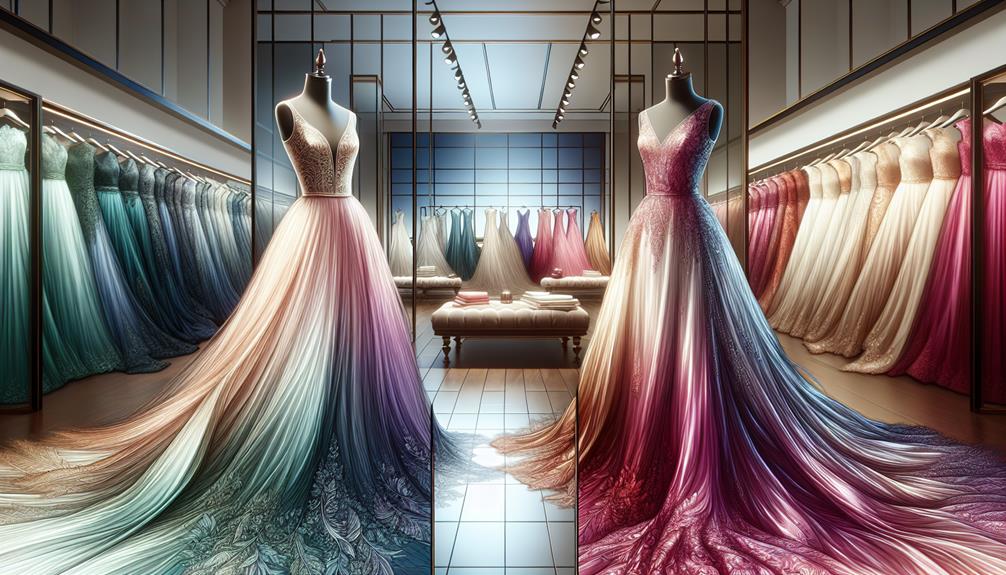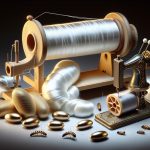Yep, chiffon is generally cheaper than silk. The reason's pretty straightforward: chiffon can be made from synthetic materials like polyester, which costs less to produce than the natural silk fibers from silkworms. Silk's got this whole luxe vibe because it's pricier, thanks to its sophisticated production process and its status as a luxury material in places like Italy and China. Chiffon, being lighter and more available, fits more budgets and styles, making it a go-to for airy, fashionable looks without breaking the bank. Interested in the nitty-gritty of why these fabrics are priced so differently? Just stick around!
Table of Contents
Key Takeaways
- Chiffon is generally less expensive than silk due to cheaper synthetic materials like polyester used in its production.
- Silk involves labor-intensive harvesting from silkworm cocoons, contributing to its higher cost.
- Chiffon's manufacturing process is less costly as it is often mass-produced using machines.
- Silk's price is influenced by its luxury status and the meticulous craftsmanship required in its production.
- Chiffon's affordability and versatility make it a popular choice in both high fashion and everyday wear, unlike the more niche luxury market for silk.
Understanding Chiffon and Silk
Chiffon and silk are two popular fabrics, but they differ significantly in texture, origin, and cost. Let's dive into what sets them apart, beyond just their price tags. I've always found that feeling the fabric gives the best clue. Silk has this smooth, luxurious feel that almost slides through your fingers. Chiffon, on the other hand, has a slight roughness, a bit of grip to it, which is great for those floaty, draping designs.
When I'm out shopping, I also pay attention to how these fabrics move. Silk flows with an elegant ease, perfect for those classy, high-end outfits. Chiffon? It's lighter and has a bit of a bounce, making it ideal for breezy, airy styles that you'd wear on a spring day.
And then there's the sheerness. Chiffon is usually more transparent, which works wonders in layers without getting too heavy. Silk is typically more opaque, which adds to its allure and sophistication.
Origins of Chiffon and Silk
Silk has a rich history, going back thousands of years in China.
Chiffon's story is a bit more modern, but it's just as interesting.
Ancient Silk Beginnings
How did the luxurious fabric silk originate thousands of years ago in ancient China?
Well, it all started with the silkworm, or more specifically, the Bombyx mori moth's larvae. These little critters produce silk fibers to make their cocoons. The story goes that a Chinese empress, Si Ling-Chi, discovered silk when a cocoon accidentally dropped into her hot tea and started to unravel. Fascinated by the shiny threads, she figured out how to weave them into cloth.
The secret of silk making was so prized that it was kept under wraps for thousands of years. If you spilled the beans on how it was made, you'd face serious consequences. So, silk became a symbol of ancient Chinese innovation and luxury.
Chiffon Fabric Development
While silk has ancient roots, chiffon's development is a more modern tale, emerging as a lightweight alternative in the early 20th century. Originally, silk was the go-to for luxury fabrics. But here's the thing: as fashion demanded lighter, more versatile materials, chiffon came into play.
It's made through a weaving process that twists yarns to give it that slight puckering, which we all love for its sheer and airy qualities. This new fabric was a hit, especially for evening wear and elegant scarves, because of its drape and floaty character. Chiffon can be made not just from silk but also from synthetic fibers, making it more accessible and, often, more affordable than traditional silk.
Production Processes Compared
Now, let's talk about how chiffon and silk are made, because it's super interesting!
Silk harvesting is all about taking care of silkworms and collecting their cocoons—it's pretty delicate work.
Chiffon, on the other hand, involves weaving which is less about bugs and more about machines and threads.
Silk Harvesting Techniques
Silk production is fascinating, especially when you look at how workers carefully harvest silk fibers from cocoons. They start by selecting the healthiest silkworms, ensuring the fibers are top quality. Once the silkworms spin their cocoons, the harvesting begins. It's a delicate process.
Workers gently steam or boil the cocoons to soften the sericin—the sticky protein that holds the silk fibers together. Then, they find the end of the silk thread and carefully unwind it. This thread is incredibly thin but super strong.
I've learned that each cocoon can produce about a mile of silk fiber! The skilled workers make sure not to break the continuous thread, which is crucial for producing high-quality silk.
Chiffon Weaving Methods
Turning to chiffon, its weaving process is quite distinct and involves weaving lightweight threads into a slightly puckered texture that gives it a sheer, elegant appearance. They use a plain weave technique, which is kinda simple but super effective for creating that soft, airy feel we all love in chiffon.
This method basically crisscrosses warp and weft threads in an alternating pattern. It's not just about throwing threads together, though. The trick is in choosing the right kind of synthetic or silk threads and how tightly they're woven. This affects how well the fabric drapes and flows.
Market Availability and Demand
The availability and demand for chiffon and silk vary widely across different markets. Let's break it down a bit. You see, silk tends to be more sought after in markets that value luxury and traditional craftsmanship. This fabric's popularity soars in places like Italy, India, and China, where they've got a long history of silk production.
Chiffon, on the other hand, is everywhere. It's not as exclusive as silk, making it a go-to for both high fashion and everyday use in a broader range of places. You're likely to find it in the U.S., Europe, and tons of Asian countries too. It's versatile, so it's used in everything from bridal wear to curtains, which keeps demand steady.
Here's a quick look at how they stack up in different countries:
| Fabric | Countries with High Demand |
|---|---|
| Silk | Italy, India, China |
| Chiffon | USA, France, Japan |
Price Comparison Analysis
Let's dive into comparing the prices of chiffon and silk to see which one's easier on your wallet. When you start looking at fabric costs, you'll notice chiffon generally costs less than silk. This price difference comes from the materials used and the manufacturing processes involved.
Chiffon can be made from synthetic materials like polyester, which is significantly cheaper than the natural fibers used in silk. Even when chiffon is made from silk, the weaving technique makes it less expensive than heavier silk fabrics. You can find chiffon for as little as $5 per yard, while silk typically starts around $15 per yard and can go much higher depending on the quality and type.
It's also worth noting that the price of silk can vary a lot based on where it's sourced and how it's processed. For example, silk from traditional producers like Italy or China might cost more due to their renowned craftsmanship and reputation.
Durability and Maintenance Costs
While chiffon might be easier on the wallet up front, it's worth considering the durability and maintenance costs of both fabrics. Let's break it down:
- Durability: Silk is naturally a more robust fabric. It comes from the cocoons of silkworms, which gives it a high tensile strength, meaning it can handle a bit more wear and tear than chiffon. Chiffon, typically made from synthetic fibers like polyester, might snag or tear easier. You've gotta think about how often you'll be wearing and washing these fabrics.
- Maintenance: Silk demands a bit more TLC. It usually requires dry cleaning rather than a simple toss in the washing machine. Chiffon, especially the synthetic versions, is generally more forgiving. You can often wash it at home, which saves bucks on dry cleaning. But remember, mishandling either fabric can lead to a shorter lifespan.
- Repair Costs: If you snag or tear silk, fixing it isn't cheap or sometimes even possible, depending on the damage. Chiffon might be easier and less costly to mend, which is something to consider if you're not all that careful with your clothes.
Styling and Use Cases
Exploring how chiffon and silk work in different styles and settings really highlights their versatility. Let's dive into the unique ways each fabric shines, depending on what you're going for.
Chiffon, with its light, airy feel, is perfect for those flowy, ethereal looks. I've used it mainly for summer dresses and delicate scarves. It's like wearing a breeze! On the other hand, silk exudes luxury and works beautifully in outfits where you want a bit of shine and smoothness. Think of those elegant evening gowns or a sleek silk blouse for a big meeting.
Here's a quick table to show some common uses of both fabrics:
| Fabric | Use Cases |
|---|---|
| Chiffon | Wedding dresses, Scarves |
| Silk | Ties, Luxurious bedding |
| Chiffon | Ballet costumes, Blouses |
| Silk | Formal suits, High-end bags |
This table isn't exhaustive but gives you a good idea of where each fabric can be a star. Whether you're crafting a casual look with chiffon or going all out with silk, understanding these uses can really elevate your style game. It's all about picking the right tool for the job!
Economic Factors Influencing Prices
Understanding the economic factors influencing the prices of chiffon and silk helps us see why one might be more affordable than the other. Let's dive into these factors without getting too lost in the economics jargon.
Here's a simple breakdown:
- Material Origin: Silk is a natural fiber produced by silkworms, primarily in Asia. It's labor-intensive and time-consuming to produce. Chiffon can be made from silk, but it's often manufactured from less expensive synthetic materials like polyester. This makes chiffon generally cheaper.
- Production Costs: Producing silk involves a lot of steps – from feeding the silkworms to spinning the fibers into thread. Each step adds to the cost. Synthetic chiffon, however, is mass-produced using machines which significantly cuts down the production costs.
- Market Demand: Silk is often viewed as a luxury material due to its texture, luster, and durability. This high demand can drive up its price. Chiffon, while popular for its lightness and flowy nature, doesn't quite hit the same luxury mark, keeping its demand, and thus price, somewhat lower.
Frequently Asked Questions
Can Chiffon and Silk Be Recycled or Upcycled Effectively?
Yes, both chiffon and silk can be effectively recycled or upcycled. I've seen some creative projects where old silk dresses are transformed into gorgeous scarves or pillow covers. It's a sustainable practice!
How Do Chiffon and Silk React to Different Weather Conditions?
I've noticed chiffon stays cool and breezy in hot weather, which is great. Silk, though, can get clingy and warm, but it's perfect for staying cozy during those cooler days.
Are There Hypoallergenic Options Available for Chiffon and Silk?
Yes, there are hypoallergenic options for both chiffon and silk. I've found that silk, especially organic silk, tends to be more hypoallergenic than regular chiffon, making it a better choice for sensitive skin.
What Ethical Concerns Exist With Chiffon and Silk Production?
I'm concerned about the ethical impacts of chiffon and silk production. Silk often involves harming silkworms, and chiffon's manufacturing can be environmentally damaging unless it's sourced responsibly. Both need careful consideration.
How Do Silk and Chiffon Affect Dye Colors and Techniques?
Silk and chiffon react differently to dyes; silk holds rich, vibrant colors well, while chiffon's lighter weave often results in softer, more subtle hues. Both require specific techniques for optimal coloration.
- What Is Similar to Chiffon? - April 23, 2024
- Which Material Is Better Crepe or Chiffon? - April 23, 2024
- How Durable Is Chiffon? - April 23, 2024







